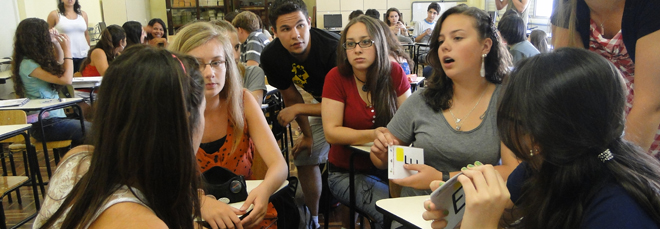We are putting the finishing touches on our probability unit and there’s one more problem that I want to show my kids. The problem goes something like this:
“What is the probability that in a group of 30 people, at least 2 people have the same birthday? Assume there are 365 days in a year.”
For this particular problem, I like to lower the level of abstraction to get everyone to buy in. I say the following: “We have 29 people in this room (including me). There are 365 days in a year. Take a guess at what the probability would be that 2 of us share the same birthday.” We aren’t talking about the birth year here, just the birthday. I ask the kids to take a guess and write it down. I want them to own their thoughts in writing. We talk to people around us to compare answers. There’s a shy kid in front who nobody turns to so I pair up with him. I poll the class to get the lowest and the highest answer and write them up on the board. Today the guesses ranged from .05 – .49.
I then ask the kids to think about how they could possibly calculate the theoretical probability and give them some time to brainstorm either by themselves or with each other. We entertain their ideas and as I’m walking around eavesdropping on conversations, I’m writing things down on the board that I’m hearing.
“365^29 – Geez that’s big”
“It’s a permutation”
“We need to use the complement”
“Let’s make this easier by using only 5 people”
After letting them wrestle with the problem for a while I realize that they are getting closer, but not quite there yet. It’s time for me to interject. I go through the solution using this strategy I read about on the “Ask Dr. Math” section of the math forum. There’s a wow factor buzzing through the classroom as we determine that in a room of 30 people there’s a .71 chance that at least 2 of them share a birthday and in a room of 90 people there’s a .99 chance. We go back to their guesses and the kid who guessed 49% gets a prize out of my ‘Box of Wow’ for being the closest.
Now it’s time for the Johnny Carson video. In this short video clip, Johnny is marveled by the probabilities of this particular problem and then polls the audience trying to find a match. It’s worth the 2 minute watch. I ask the kids to talk about their reaction to the video. Did Johnny do something wrong here or we witnessing a statistical anomaly right before our eyes?
There are still some doubter’s in the class so someone suggests we try it out. I jump on the opportunity to quickly discuss the differences of theoretical and statistical probability. There’s 3 minutes left in the period so we begin going up and down the rows having the kids state their birthdays. I start with September 23. Up one row and down the next, no matches. As we get to the last two rows there’s both excitement yet disappointment showing on the faces of my kids. Now there’s 3 kids left. “March 22” says one of them, the next kid in line smiles wide as she calmly says “Me too.” The bell rings.

I love a lesson that includes lots of thinking, exploring, as well as different media (like a video clip). Thanks for sharing your lesson! 🙂
This sounds a great lesson with pupils interested and engaged. Thanks for sharing.
Isn’t it great when the timing works out that way? Love the problem and your engagement with the students.
In case you haven’t seen, there’s an empirical investigation of the birthday question that found September 16th is the most probable birthday date; Feb 29th was least probable (surprise!): http://thedailyviz.com/2012/05/18/how-common-is-your-birthday-pt-2/
Thanks Andrew, I will give that a look.